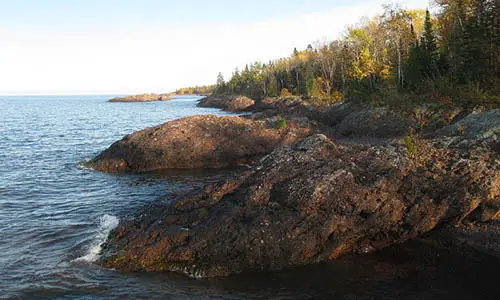The Great Lakes form the largest surface fresh water system in the world. Though formed about a billion years ago, they are one of the youngest natural features of North America. They are also called freshwater Seas. The five lakes between them hold one fifth of the world’s supply of fresh surface water supply and nine tenths of the US supply. The Lakes hold approximately 6 quadrillion (1 followed by 15 zeroes) gallons of water. If this water was spread out over all of USA it would be 9.5 feet deep.
FACT 1: Lake Superior as its name implies is the greatest of the great lakes. The other four lakes, Michigan, Huron, Erie and Ontario are also very large. All the Great Lakes are among the 18largest lakes in the world. The name Superior also refers to its position in the system. It is the northern most lake and can be considered the first lake in the system.
FACT 2: Lake Superior is the largest body of surface fresh water on Earth. It is 257 km wide and 563 km long. It has a surface area of 82,100km. The volume of water held in the Lake is 12.100cubic km.
FACT 3: The Lake is so deep it rarely freezes completely. The deepest point is measured at 400 meters. The last time there was a complete freeze over was in 1997. There was a near complete freeze in 2003. Despite its depth, the water is clear and visibility is about 8.2 m.
FACT 4: Lake Superior was first explored in the mid 1600’s by a French Expedition led by Samuel de Champlain. Native American Indians inhabited the regions around the Lake long before the arrival of the Europeans.
FACT 5: The French and British Colonists used Lake Superior as a major mode of transport for the fur trade. It is still a major shipping hub, with 10 ports and harbours servicing both USA and Canada.
FACT 6: The varying depths and unpredictable weather conditions on Lake Superior make it an accident prone spot for ships. On Nov 10, 1975 the ‘Edmund Fitzgerald’ was sailing south on the Lake carrying iron ore. This freighter was considered to be invincible as was the Titanic. However the vessel encountered high winds, not unusual for a water body with a large surface area. The wind speed on that day was about 69 mph. The high waves (about 25 ft)were the unexpected factor. This severe storm sank the freighter and 29 crew members died.
FACT 7: Many birds including hawks, loons, owls and woodpeckers can be seen on the shores of the Lake. North America has only 2 crane species. The endangered whooping crane is found on the northern shores of the Lake. During the fall migration period, about 10,000 migrating birds of prey pass through Duluth’s Hawk Ridge on the shores of the lake.
FACT 8: Fishing is an important commercial activity on the Lake. Record harvests of commercial fishing were reported in the late 1800’s. Since then over fishing and the introduction of non native invasive species, has led to the decline in the fishing potential of the lake. Successful efforts have been made by both USA and Canada to reverse this trend. Herring, rainbow smelt whitefish and yellow perch are harvested on Lake Superior.
FACT 9: The area around the Lake lost most of its pine forests to the intense logging activities of the colonists in the 1800’s. Native flora was also lost to the introduction of non native invasive species like the purple loosestrife.
FACT 10: Lake Superior is so large that its wolf head shape can be spotted from the Moon!











Leave a Reply